ADVERTISEMENT
| |
- Simplify:
 Since the radical is the same in each term (namely, the square root of three), I can combine the terms. I have two copies of the radical, added to another three copies. This gives me five copies:
Since the radical is the same in each term (namely, the square root of three), I can combine the terms. I have two copies of the radical, added to another three copies. This gives me five copies:
- Simplify:
 The radical part is the same in each term, so we can do this addition. To help me keep track that the first term means "one copy of the square root of three", I'll insert the "understood" "1":
The radical part is the same in each term, so we can do this addition. To help me keep track that the first term means "one copy of the square root of three", I'll insert the "understood" "1":

- Simplify:
 To simplify a radical addition, I must first see if I can simplify each radical term. In this particular case, the square roots simplify "completely" (that is, down to whole numbers):
To simplify a radical addition, I must first see if I can simplify each radical term. In this particular case, the square roots simplify "completely" (that is, down to whole numbers):
- Simplify:
![3 sqrt[4] + 2 sqrt[4]](http://www.purplemath.com/modules/radicals/rad047.gif)
- I have three copies of the radical, plus another two copies, giving me— Wait a minute! I can simplify those radicals right down to whole numbers:
- Simplify:
![3 sqrt[8] + 5 sqrt[2]](http://www.purplemath.com/modules/radicals/rad052.gif) Copyright © Elizabeth Stapel 1999-2011 All Rights Reserved
I can simplify the radical in the first term, and this will create "like" terms:
Copyright © Elizabeth Stapel 1999-2011 All Rights Reserved
I can simplify the radical in the first term, and this will create "like" terms: - Simplify: I can simplify most of the radicals, and this will allow for at least a little simplification:
- Simplify:
 These two terms have "unlike" radical parts, and I can't take anything out of either radical. Then I can't simplify the expression
These two terms have "unlike" radical parts, and I can't take anything out of either radical. Then I can't simplify the expression - Expand:
](http://www.purplemath.com/modules/radicals/rad058.gif) To expand (that is, to multiply out and simplify) this expression, I first need to take the square root of two through the parentheses:
To expand (that is, to multiply out and simplify) this expression, I first need to take the square root of two through the parentheses:
![3 sqrt[8] + 5 sqrt[2] = 3 sqrt[(2 * 2) * 2] + 5 sqrt[2] = 3 * 2 sqrt[2] + 5 sqrt[2] = 6 sqrt[2] + 5 sqrt[2] = 11 sqrt[2]](http://www.purplemath.com/modules/radicals/rad053.gif)
(expression is already fully simplified)
 = 3 sqrt[2] + sqrt[2 * 3] = 3 sqrt[2] + sqrt[6]](http://www.purplemath.com/modules/radicals/rad059.gif)
- Expand:


- Expand:
![(1 + sqrt[2])(3 - sqrt[2])](http://www.purplemath.com/modules/radicals/rad060.gif) It will probably be simpler to do this multiplication "vertically".
It will probably be simpler to do this multiplication "vertically".
![(1 + sqrt[2])(3 - sqrt[2]) = -1sqrt[2] - sqrt[2]sqrt[2] + 3 + 3sqrt[2] = 3 + 2sqrt[2] - sqrt[2 * 2]](http://www.purplemath.com/modules/radicals/rad061.gif)
Quiz.
1.
Answer: Since the radicals are the same, simply add the numbers in front of the radicals (do NOT add the numbers under the radicals).
2. Since the radicals are the same, simply add the numbers in front of the radicals (do NOT add the numbers under the radicals).
3.
| 1. Simplify | Answer: | |||
| 2. Simplify | Answer: | |||
| 3. Since the radicals in steps 1 and 2 are now the same, we can combine them. | Answer: | |||
| 4. After combining, you are left with: | Answer: | |||
| 5. Can you combine these radicals? | Answer: NO | |||
| 6. Therefore, | ||||
![sqrt[18] - 2 sqrt[27] + 3 sqrt[3] - 6 sqrt[8] = sqrt[(3 * 3) * 2] - 2 sqrt[(3 * 3) *3)] + 3 sqrt[3] - 6 sqrt[(2 * 2) * 2] = 3 sqrt[2] - 6 sqrt[3] + 3 sqrt[3] - 12 sqrt[2] = -9 sqrt[2] - 3 sqrt[3]](http://www.purplemath.com/modules/radicals/rad055.gif)
No comments:
Post a Comment